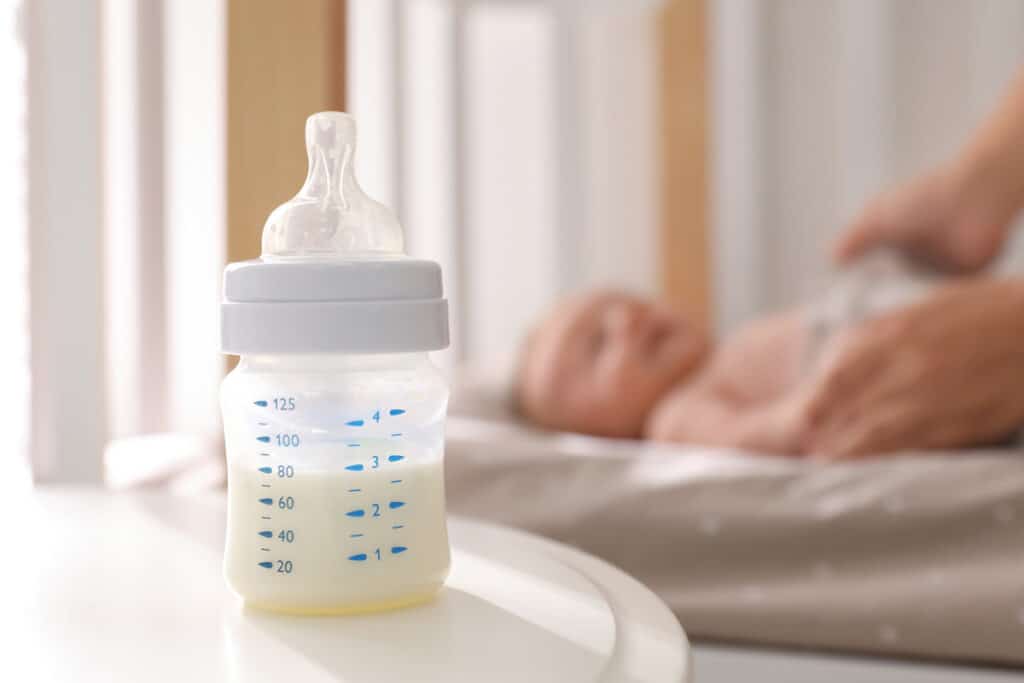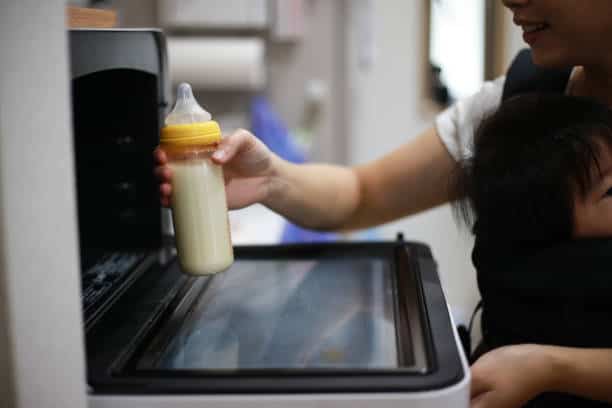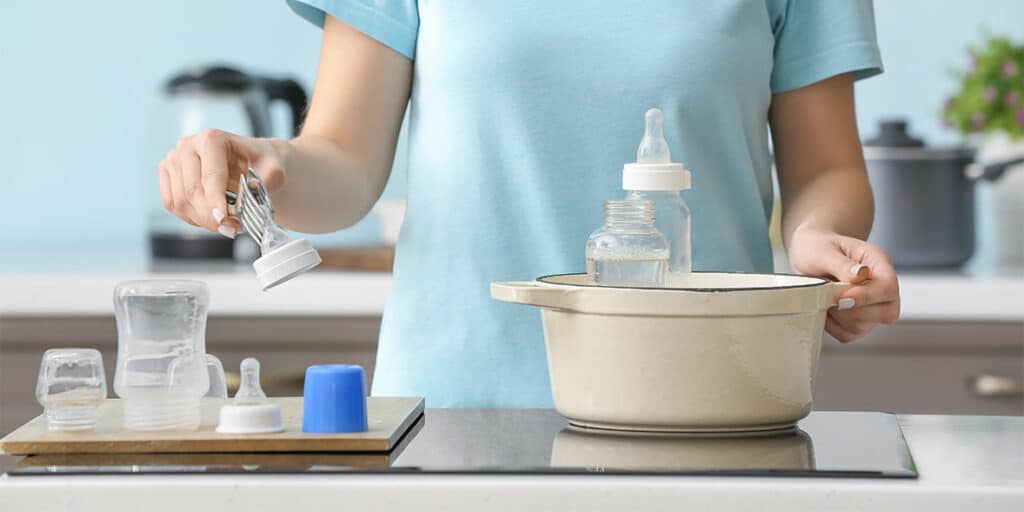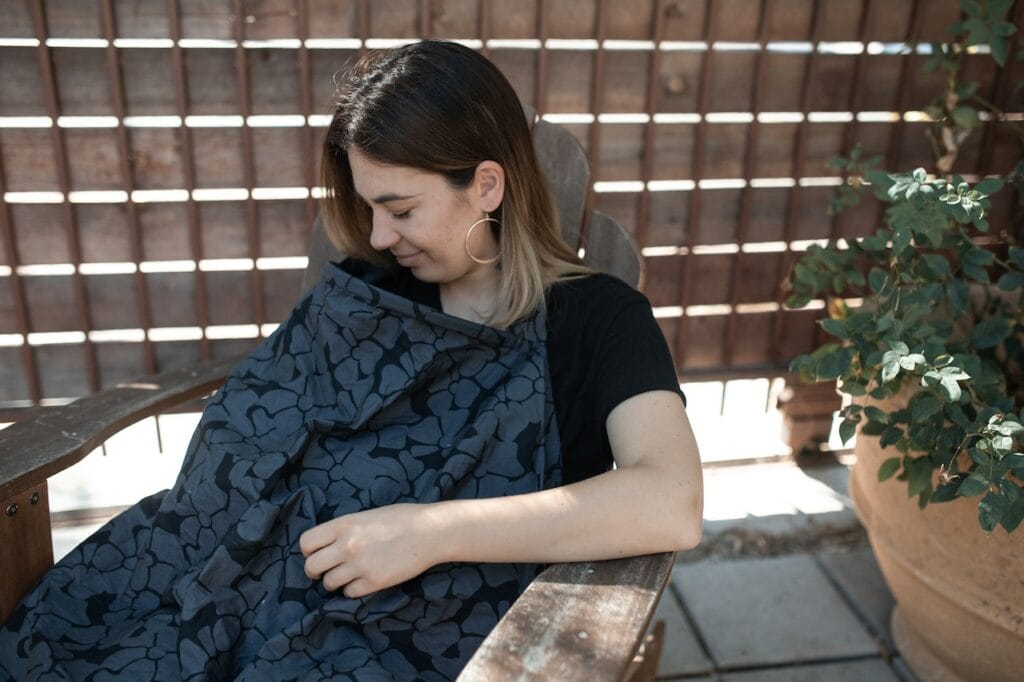Breast milk is a vital source of nutrition for infants, providing them with essential nutrients and antibodies that help protect against infections and illnesses. However, when it comes to storing and serving breast milk, there are certain guidelines that must be followed to ensure its safety and nutritional value. One common question that many new mothers have why cant you add warm breast milk to cold.
Breast milk is typically stored in the refrigerator or freezer to preserve its quality and freshness. When it comes time to feed the baby, some mothers may want to combine milk of different temperatures to create a more comfortable drinking temperature. However, adding warm breast milk to cold can be problematic and may even pose a risk to the baby’s health.
Key Takeaways
- Combining warm and cold breast milk can create a breeding ground for harmful bacteria.
- Breast milk should be stored and served according to established guidelines to ensure its safety and nutritional value.
- Consultation with a healthcare provider or lactation consultant can provide valuable guidance on breast milk storage and feeding practices.
Understanding Breast Milk Temperature
Breast milk is a valuable source of nutrition for infants, and its temperature is crucial for maintaining its nutritional value. The temperature of breast milk can vary depending on the time of day and the mother’s body temperature. It is essential to understand the different temperatures of breast milk and their effects on the baby.

1. Temperature of Breast Milk
Breast milk is typically produced at a temperature of around 98.6°F (37°C), which is the same as the mother’s body temperature. However, the temperature of breast milk can vary slightly depending on the time of day and the mother’s body temperature. It is also affected by the temperature of the environment in which it is stored.
2. Warm Breast Milk
Warm breast milk is typically at or near body temperature, which is around 98.6°F (37°C). This temperature is ideal for feeding infants because it is similar to the temperature of breast milk when it is produced. Warm breast milk is also easier for infants to digest and is less likely to cause discomfort or colic.
3. Cold Breast Milk
Cold breast milk is typically stored in a refrigerator at a temperature of around 39°F (4°C). This temperature is safe for storing breast milk but may not be ideal for feeding infants. Cold breast milk may cause discomfort or colic in infants and may be less nutritious than warm breast milk.
4. Room Temperature Milk
Room temperature milk is breast milk that has been left out at room temperature for up to four hours. The temperature of room temperature milk can vary depending on the temperature of the environment. It is generally safe to feed infants room temperature milk, but it may not be as nutritious as warm breast milk.
In conclusion, understanding the temperature of breast milk is crucial for maintaining its nutritional value and ensuring that it is safe for infants to consume. Warm breast milk is the ideal temperature for feeding infants, while cold breast milk may cause discomfort or colic. Room temperature milk is generally safe to feed infants but may not be as nutritious as warm breast milk.
Breast Milk Storage Guidelines
Proper breast milk storage is essential to ensure that babies receive safe and healthy milk. Here are some general guidelines for storing breast milk:
- Freshly pumped milk can be stored at room temperature for up to 4 hours.
- Refrigerated milk should be used within 4 days.
- Frozen milk can be stored for up to 6 months in a standard freezer and up to 12 months in a deep freezer.
- It’s best to store milk in small quantities, such as 2-4 ounces, to avoid waste.

When storing breast milk, it’s important to use clean containers and to label them with the date and time the milk was expressed. Plastic or glass containers with tight-fitting lids are ideal for storage.
It’s not recommended to add warm breast milk to cold milk or to mix milk that has been pumped at different times. This is because adding warm milk to cold milk can cause the temperature to rise too quickly, which can promote the growth of bacteria. Additionally, mixing milk that has been pumped at different times can lead to inconsistencies in the milk’s nutrient content.
Breast milk can be stored in the refrigerator or freezer, but it’s important to note that the temperature of the refrigerator and freezer can affect the milk’s quality. The ideal temperature for storing breast milk in the refrigerator is between 32 and 39 degrees Fahrenheit, while the ideal temperature for storing breast milk in the freezer is 0 degrees Fahrenheit.
Overall, following proper breast milk storage guidelines can help ensure that babies receive safe and healthy milk.
Combining Breast Milk of Different Temperatures
Breast milk is a valuable source of nutrition for babies, providing them with the essential nutrients they need for healthy growth and development. However, when it comes to combining breast milk of different temperatures, there are a few things to keep in mind.
Mixing breast milk of different temperatures can be a concern for many parents. Some worry that combining warm and cold breast milk can be harmful to their baby’s health. However, the truth is that combining breast milk of different temperatures is safe as long as it is done correctly.
One way to combine breast milk of different temperatures is by using the pitcher method. This involves adding freshly expressed breast milk to a container of previously expressed breast milk, which is at a different temperature. The milk is then stirred gently to combine the two temperatures.
Another way to combine breast milk of different temperatures is by layering the milk. This involves adding freshly expressed breast milk to a container of previously expressed breast milk, which is at a different temperature. The milk is then allowed to settle for a few minutes, which allows the layers to form. The layers can then be gently mixed together before feeding the baby.
It is important to note that breast milk should never be microwaved or boiled, as this can destroy the valuable nutrients it contains. Instead, breast milk should be gently warmed by placing the container of milk in warm water or using a bottle warmer.
In conclusion, combining breast milk of different temperatures is safe as long as it is done correctly. The pitcher method and layering are both effective ways to combine breast milk of different temperatures. It is important to avoid microwaving or boiling breast milk and to gently warm it before feeding the baby.
The Role of Bacteria in Breast Milk
Breast milk is a complex and dynamic fluid that provides optimal nutrition and immune protection to infants. However, breast milk can also be a source of bacterial contamination, which can lead to spoilage and potential health risks for the infant.

Bacteria are naturally present in breast milk, and their role is complex. Some bacteria are beneficial and can contribute to the development of the infant’s immune system. For example, bifidobacteria are commonly found in breast milk and can help prevent infections and promote healthy gut flora.
However, other bacteria can cause spoilage and contamination of breast milk. When breast milk is expressed, it is typically sterile. However, as soon as it is exposed to the environment, it can become contaminated with bacteria.
Bacterial growth in breast milk can occur at different rates depending on various factors, including temperature, pH, and the presence of nutrients. Warm breast milk provides an ideal environment for bacterial growth, as it is rich in nutrients and has a neutral pH.
If warm breast milk is added to cold breast milk, the temperature differential can create a favorable environment for bacterial growth and increase the risk of contamination. Additionally, if breast milk is stored at room temperature for too long, bacteria can proliferate rapidly, leading to spoilage and potential health risks for the infant.
In summary, bacteria play a complex role in breast milk, and their growth and presence can have both positive and negative effects on infant health. It is important to handle and store breast milk properly to minimize the risk of contamination and spoilage.
The Impact on Nutritional Value
When breast milk is warmed, it loses some of its nutritional value. This is because heat breaks down the essential nutrients in breast milk. Vitamin C, for example, is a nutrient that is particularly sensitive to heat. When breast milk is warmed, the vitamin C content decreases significantly.
It is important to note that breast milk still contains more nutrients than formula, even when warmed. However, if the temperature of the milk is too high, it can cause further degradation of the nutrients. Therefore, it is recommended to warm breast milk slowly and gently, and to avoid overheating it.
Some mothers may be concerned that warming breast milk in a bottle warmer or microwave can destroy the nutritional value of the milk. While it is true that microwave heating can cause uneven heating and hot spots, which can lead to nutrient loss, using a bottle warmer or warming breast milk in a bowl of warm water is a safe and effective way to warm breast milk without compromising its nutritional value.
In conclusion, warming breast milk can have an impact on its nutritional value, particularly the vitamin C content. However, breast milk still remains the best source of nutrition for infants, even when warmed. It is important to warm breast milk slowly and gently, and to avoid overheating it to preserve its essential nutrients.
Breastfeeding and Pumping Sessions
Breastfeeding is a natural process that provides optimal nutrition and immune support for babies. Nursing mothers often choose to pump breast milk for various reasons, including returning to work or increasing milk supply. However, it is important to understand the proper handling of breast milk to ensure its safety and quality.
During pumping sessions, breast milk is collected in a bottle or storage bag. It is important to label the container with the date and time of expression. Breast milk can be stored in the refrigerator or freezer until it is needed.
When combining breast milk from different pumping sessions, it is important to cool the milk before adding it to previously refrigerated milk. Adding warm breast milk to cold milk can cause the temperature to rise, promoting bacterial growth and potentially compromising the quality of the milk.
It is recommended to cool freshly expressed breast milk in the refrigerator for at least an hour before combining it with previously chilled milk. The same principle applies when thawing frozen breast milk. Thawed milk should be refrigerated and cooled before adding it to cold milk.
Breastfeeding and pumping sessions require proper handling and storage of breast milk to ensure its safety and quality. By following these guidelines, nursing mothers can provide their babies with the best possible nutrition and immune support.
Using Apps and Labeling for Breast Milk Storage
When it comes to breast milk storage, it’s important to be organized and keep track of the age of the milk. One way to do this is by using apps specifically designed for breast milk storage. These apps allow you to input the date and time the milk was expressed, as well as the amount and any notes you want to add. This can be especially helpful for mothers who are pumping at work or on-the-go, as it ensures that the oldest milk is used first and not wasted.

Another important aspect of breast milk storage is labeling. It’s important to label each container with the date the milk was expressed, as well as the amount and any other relevant information. This can be done with a permanent marker or an erase marker, depending on your preference. Erase markers are a great option for mothers who want to reuse their containers, as the label can easily be wiped off with a damp cloth.
In addition to labeling, it’s important to store breast milk in a way that ensures the oldest milk is used first. This can be done by placing the newest milk in the back of the fridge or freezer and the oldest milk in the front. You can also use a system of rotating milk, where you use the oldest milk first and replace it with the newest milk.
Overall, using apps and labeling can help mothers keep track of their breast milk storage and ensure that their milk is being used in the proper order. By taking these steps, mothers can feel confident that their baby is receiving the freshest milk possible.
Consultation and Recommendations
Consulting with a pediatrician or lactation consultant can be helpful in understanding why warm breast milk should not be added to cold milk. These professionals have extensive knowledge and experience in infant nutrition and can provide valuable insights on how to properly handle breast milk.
Pediatricians may recommend that parents warm up breast milk before feeding it to their baby, as cold milk can cause discomfort and digestive issues. However, they advise against adding warm milk to cold milk, as it can lead to bacterial growth and spoilage. Lactation consultants also recommend against this practice, as it can affect the nutrients and quality of the milk.
To properly handle breast milk, it is recommended to follow these guidelines:
- Always wash hands before handling breast milk
- Store milk in clean, sterile containers
- Label milk with the date and time it was expressed
- Store milk in the refrigerator or freezer immediately after expression
- Thaw frozen milk in the refrigerator or under warm running water
- Use thawed milk within 24 hours
- Do not refreeze thawed milk
In summary, consulting with a pediatrician or lactation consultant can provide valuable information on how to properly handle and store breast milk. It is important to follow their recommendations to ensure the safety and quality of the milk for your baby’s nutrition.
Special Considerations for Preemies
Preemies have special considerations when it comes to feeding, and this includes warming breast milk. Preemies are at a higher risk for infections and illnesses, and it’s important to take extra precautions to protect their health.
When warming breast milk for a preemie, it’s important to follow the guidelines provided by the healthcare provider or lactation consultant. These guidelines may include using a specific temperature range or method for warming the milk.
It’s also important to note that preemies may have different feeding needs than full-term infants. They may need smaller, more frequent feedings, and may require additional supplements or fortifiers in their breast milk.
When it comes to warming breast milk for a preemie, there are a few additional considerations to keep in mind:
- Use a bottle warmer or warm water bath to warm the milk. Avoid using a microwave, as this can create hot spots in the milk and may cause burns.
- Check the temperature of the milk before feeding. It should be warm, but not hot.
- Discard any leftover milk after a feeding, as bacteria can grow quickly in breast milk.
- Wash bottles and pump parts thoroughly after each use to prevent the spread of germs.
By taking these precautions and following the guidelines provided by healthcare professionals, parents can safely warm breast milk for their preemie and help support their growth and development.
Observing Differences in Breast Milk
Breast milk is a complex and dynamic substance that changes over time and can vary in composition between different mothers and even between the left and right breasts of the same mother. One of the most noticeable differences in breast milk is its color, which can range from creamy white to blue, yellow, or even green.

The color of breast milk is influenced by a number of factors, including the mother’s diet, the stage of lactation, and the presence of certain compounds such as carotenoids, which can give milk a yellow or orange hue. Colostrum, the first milk produced after birth, is often thicker and more yellow in color than mature milk.
In addition to color, breast milk can also vary in consistency and composition. For example, foremilk, the milk that is produced at the beginning of a feeding, is thinner and lower in fat than hindmilk, which is produced later in the feeding and has a higher fat content. This difference in composition is important because it helps to ensure that the baby receives the appropriate balance of nutrients and energy.
It is important to note that breast milk from the left and right breasts can also differ in composition, with some studies suggesting that the milk produced by the right breast may contain more fat than the milk produced by the left breast. This difference may be due to variations in milk ducts or other anatomical factors.
When it comes to adding warm breast milk to cold, it is generally recommended to avoid doing so because it can cause the fat in the milk to separate and form clumps. This can make the milk less nutritious and less appealing to the baby. Instead, it is recommended to warm the milk gradually by placing the bottle in a bowl of warm water or using a bottle warmer.
In summary, breast milk is a complex and dynamic substance that can vary in color, consistency, and composition. It is important to be aware of these differences and to handle breast milk carefully to ensure that it remains nutritious and safe for the baby.
Warming and Thawing Breast Milk
Warming breast milk is an essential step before feeding a baby. However, it is important to know that adding warm breast milk to cold milk is not recommended. Here’s why:
When breast milk is refrigerated or frozen, the fat in the milk separates and rises to the top. Adding warm milk to cold milk can cause the fat to clump together, making it difficult to mix the milk evenly. This can result in uneven distribution of nutrients and fat, which can impact the baby’s growth and development.
To warm breast milk, there are a few methods that can be used:
- Bottle warmer: A bottle warmer is a convenient and easy way to warm up breast milk. Simply place the bottle in the warmer and wait for it to heat up to the desired temperature.
- Warm water: Another way to warm breast milk is to place the bottle in a bowl of warm water. Make sure the water is not too hot and that the bottle is not submerged completely.
- Thawed breast milk: If using thawed breast milk, it is important to warm it up slowly to avoid overheating and destroying the nutrients. Place the bottle in warm water and swirl it gently until it reaches the desired temperature.
- Defrosted milk: If using defrosted milk, it is important to use it within 24 hours and not refreeze it. Thawed milk should never be microwaved as it can destroy the nutrients and create hot spots.
- Cold bottle: If the breast milk is too cold, it is recommended to warm it up before feeding the baby. Cold milk can cause discomfort and shock to the baby’s digestive system.
- Shake the bottle: It is important to avoid shaking the bottle vigorously as this can cause air bubbles to form, which can lead to excessive gas and discomfort for the baby.
In summary, warming breast milk is an important step before feeding a baby. However, adding warm milk to cold milk is not recommended as it can cause the fat to clump together and affect the distribution of nutrients. There are various methods to warm up breast milk, including using a bottle warmer, warm water, thawed breast milk, and defrosted milk. It is important to avoid shaking the bottle vigorously and to use thawed milk within 24 hours.
Related post: Spoiled Breast Milk Appearance
Frequently Asked Questions
How long can breast milk be stored in the fridge?
Breast milk can be stored in the fridge for up to 4 days. It is recommended to store breast milk in the back of the fridge, where the temperature is cooler and more consistent.
Can you mix breast milk that has been refrigerated with room temperature breast milk?
Yes, you can mix breast milk that has been refrigerated with room temperature breast milk. However, it is important to cool the room temperature breast milk in the fridge before mixing it with the refrigerated breast milk.
Is it safe to add warm breast milk to cold?
No, it is not safe to add warm breast milk to cold breast milk. This is because warm breast milk can cause bacteria to grow rapidly in the cold milk, which can lead to the milk spoiling and becoming unsafe for the baby to consume.
What is the recommended method for warming breast milk?
The recommended method for warming breast milk is to place the bottle of breast milk in a bowl of warm water. It is important to never microwave breast milk, as this can cause hot spots in the milk that can burn the baby’s mouth.
Can you reheat breast milk that has already been warmed?
No, it is not recommended to reheat breast milk that has already been warmed. This is because reheating breast milk multiple times can cause the milk to lose its nutritional value and increase the risk of bacteria growth.
Are there any risks associated with using the pitcher method for warming breast milk?
Yes, there are risks associated with using the pitcher method for warming breast milk. This method involves placing a bottle of breast milk in a pitcher of warm water. However, it is difficult to ensure that the water temperature is consistent and safe for the baby. It is recommended to use the bowl of warm water method instead.

Iesha is a loving mother of 2 beautiful children. She’s an active parent who enjoys indoor and outdoor adventures with her family. Her mission is to share practical and realistic parenting advice to help the parenting community becoming stronger.
